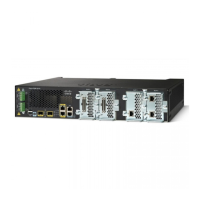31-11
Catalyst 3550 Multilayer Switch Software Configuration Guide
78-11194-09
Chapter 31 Configuring IP Unicast Routing
Configuring IP Addressing on Layer 3 Interfaces
Routing Assistance When IP Routing is Disabled
These mechanisms allow the switch to learn about routes to other networks when it does not have IP
routing enabled:
• Proxy ARP, page 31-11
• Default Gateway, page 31-11
• ICMP Router Discovery Protocol (IRDP), page 31-12
Proxy ARP
Proxy ARP, the most common method for learning about other routes, enables an Ethernet host with no
routing information to communicate with hosts on other networks or subnets. The host assumes that all
hosts are on the same local Ethernet and that they can use ARP to determine their MAC addresses. If a
switch receives an ARP request for a host that is not on the same network as the sender, the switch
evaluates whether it has the best route to that host. If it does, it sends an ARP reply packet with its own
Ethernet MAC address, and the host that sent the request sends the packet to the switch, which forwards
it to the intended host. Proxy ARP treats all networks as if they are local and performs ARP requests for
every IP address.
Proxy ARP is enabled by default. To enable it after it has been disabled, see the “Enable Proxy ARP”
section on page 31-10. Proxy ARP works as long as other routers support it.
Default Gateway
Another method for locating routes is to define a default router or default gateway. All nonlocal packets
are sent to this router, which either routes them appropriately or sends an IP Control Message Protocol
(ICMP) redirect message back, defining which local router the host should use. The switch caches the
redirect messages and forwards each packet as efficiently as possible. A limitation of this method is that
there is no means of detecting when the default router has gone down or is unavailable.
Beginning in privileged EXEC mode, follow these steps to define a default gateway (router) when IP
routing is disabled:
Use the no ip default-gateway global configuration command to disable this function.
This example shows how to set and verify a default gateway:
Switch(config)# ip default-gateway 10.1.5.59
Switch(config)# end
Switch# show ip redirect
Default gateway is 10.1.5.59
Host Gateway Last Use Total Uses Interface
ICMP redirect cache is empty
Command Purpose
Step 1
configure terminal Enter global configuration mode.
Step 2
ip default-gateway ip-address Set up a default gateway (router).
Step 3
end Return to privileged EXEC mode.
Step 4
show ip redirects Display the address of the default gateway router to verify the
setting.
Step 5
copy running-config startup-config (Optional) Save your entries in the configuration file.

